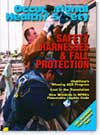
December 2003
Features
By Jeanette Keton
WHEN a man playing tennis at a ClubCorp Inc. resort in Austin, Texas, appeared to be suffering chest pains, ClubCorp employees responded quickly. Within 30 seconds, the company's specially trained team brought an automated external defibrillator (AED) to the man's side.
By Andrea Clark
REPORTING requirements for a facility can cover a broad spectrum of laws, regulations, and standards at the federal, state, and local levels. These requirements may apply to a variety of media, such as air, land, water, and waste.
By Dennis Hutchinson
ACCIDENT Intervention Systems, as the term pertains to safety in industrial, manufacturing, and distribution facilities, is defined as: A systems approach to in-plant safety, where the three areas of Risk Management--People Protection, Property Protection and Code Compliance--are assessed and proper procedure is taken to neutralize workplace hazards and improve code compliance.
By Mark Altmann
LOSING a valuable employee heavily impacts the organization on many levels: the loss of productivity, the impact to company morale, the employee safety and security issues, and risk and liability issues.
By Bernard R. Blais, M.D., FAAO, FACOEM, FACS, Thomas Tredici, Sr., M.D.
THE present status of ocular engineering now allows for many new concepts that change or modify the optical system of the eye. Some of these are corrections for existing ocular impairments, but they require completely new approaches to the fitness-for-duty status and qualifying of incumbents or existing employees. Let's consider a few of these changes.
By Philip Fillweber
FOR almost a century, NFPA 30 has guided users of flammable and combustible liquids. From 1913 to 1957, the document was published as a model municipal ordinance. In 1957, the format was changed to a code, although the technical requirements and provisions remained the same.
By Fred Goodnight
IT was a Monday night last May at Las Palmitas, a restaurant in Coeur d'Alene, Idaho, when a fire broke out in its lounge filled with a crowd of 200 customers.
By Roger Brooks, Jr.
ON a cold November evening in Michigan last year, a 20-year-old Hispanic worker was killed while removing bridge formwork as he stood atop an elevated truck bed. When he and a co-worker attempted to lower the platform, which could also serve as a dump truck, the bed malfunctioned and would not go down.
By Emmett McGregor
THREE hundred feet in the air, stepping from girder to girder, the last thing I want running through my head is a question regarding the safety equipment I am using. Will the fundamental design of that equipment in fact save my life, or will it actually take it from me? Will I be home watching the ballgame with my family tonight, or will they be preparing for my funeral?
By Stephen V. Magyar, Jr., MBA, CSP
FIRE, tornado, bomb threat, hazardous material spill--all are emergencies that can, and often do, strike without warning. They are disruptive to normal operations. They frequently cause serious injury, property damage, and production downtime.
Departments
By Jerry Laws
OSHA's new fiscal year began Oct. 1 and within hours the new-for-2004 Form 300 (Log of Work-Related Injuries and Illnesses) was unveiled. OSHA announced in December 2002 it would add a separate column for hearing loss cases but would not add a column for musculoskeletal disorders.
By Valerie Weadock
EVEN in the worst of weather, Santa can depend on Rudolph to deliver him and his famous bag of goodies to millions of rooftops, safe and sound. But with a shortage of flying reindeer and magical sleighs, ensuring your employees and/or products are safely transported can be more daunting than sliding down a chimney.
By Matthew A. Forck
THIS safety thing really makes me scratch my head. One would think our workers, with their expansive job knowledge and physical skills, would perform their job safely all of the time, yet sometimes corners are cut. There seems to be a space between what a worker knows is safe and what he actually does (an at-risk act).